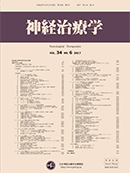36 巻, 4 号
選択された号の論文の73件中51~73を表示しています
シンポジウム12:種々の症状を呈する難治性疾患における中枢神経感作の役割の解明とそれによる患者ケアの向上
-
2019 年36 巻4 号 p. 505-507
発行日: 2019年
公開日: 2020/04/24
PDF形式でダウンロード (414K) -
2019 年36 巻4 号 p. 508
発行日: 2019年
公開日: 2020/04/24
PDF形式でダウンロード (225K) -
2019 年36 巻4 号 p. 509-512
発行日: 2019年
公開日: 2020/04/24
PDF形式でダウンロード (846K)
シンポジウム13:α–シヌクレイノパチーの臨床と基礎
-
2019 年36 巻4 号 p. 513
発行日: 2019年
公開日: 2020/04/24
PDF形式でダウンロード (72K) -
2019 年36 巻4 号 p. 514
発行日: 2019年
公開日: 2020/04/24
PDF形式でダウンロード (197K) -
2019 年36 巻4 号 p. 515-518
発行日: 2019年
公開日: 2020/04/24
PDF形式でダウンロード (576K) -
2019 年36 巻4 号 p. 519-521
発行日: 2019年
公開日: 2020/04/24
PDF形式でダウンロード (875K) -
2019 年36 巻4 号 p. 522
発行日: 2019年
公開日: 2020/04/24
PDF形式でダウンロード (128K)
シンポジウム14:Alzheimer病研究の新しい潮流
-
2019 年36 巻4 号 p. 523
発行日: 2019年
公開日: 2020/04/24
PDF形式でダウンロード (294K) -
2019 年36 巻4 号 p. 524-527
発行日: 2019年
公開日: 2020/04/24
PDF形式でダウンロード (575K) -
2019 年36 巻4 号 p. 528-530
発行日: 2019年
公開日: 2020/04/24
PDF形式でダウンロード (746K) -
2019 年36 巻4 号 p. 531
発行日: 2019年
公開日: 2020/04/24
PDF形式でダウンロード (174K) -
2019 年36 巻4 号 p. 532-536
発行日: 2019年
公開日: 2020/04/24
PDF形式でダウンロード (1273K)
シンポジウム15:未承認薬の承認への道筋と課題
-
2019 年36 巻4 号 p. 537
発行日: 2019年
公開日: 2020/04/24
PDF形式でダウンロード (226K) -
2019 年36 巻4 号 p. 538
発行日: 2019年
公開日: 2020/04/24
PDF形式でダウンロード (149K) -
2019 年36 巻4 号 p. 539-542
発行日: 2019年
公開日: 2020/04/24
PDF形式でダウンロード (450K) -
2019 年36 巻4 号 p. 543-546
発行日: 2019年
公開日: 2020/04/24
PDF形式でダウンロード (947K) -
2019 年36 巻4 号 p. 547
発行日: 2019年
公開日: 2020/04/24
PDF形式でダウンロード (166K)
原著
-
2019 年36 巻4 号 p. 548-551
発行日: 2019年
公開日: 2020/04/24
PDF形式でダウンロード (629K)
神経治療最前線 海外学会参加報告
-
2019 年36 巻4 号 p. 552-553
発行日: 2019年
公開日: 2020/04/24
PDF形式でダウンロード (482K)
-
2019 年36 巻4 号 p. 554-557
発行日: 2019年
公開日: 2020/04/24
PDF形式でダウンロード (366K) -
2019 年36 巻4 号 p. 559
発行日: 2019年
公開日: 2020/04/24
PDF形式でダウンロード (158K) -
2019 年36 巻4 号 p. 560
発行日: 2019年
公開日: 2020/04/24
PDF形式でダウンロード (144K)
